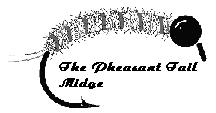

Hook: Tiemco 2487 (scud hook) or equivalent, #16-22
Bead: Black (or other color) Bead in size appropriate to hook size
Thread: Black (or color of feather barbule)
Ribbing: Fine Copper (or other color) Wire
Tail & Body: 2 Ring Neck Pheasant Tail Fibres or Turkey Feather Barbules
either natural or dyed
TYING INSTRUCTIONS:
1. Slip bead over end of hook and slide it around to just behind the eye.
Position hook in vise so that eye is slightly down. This will hold bead
in position just behind the eye and keep it from slipping back on you
while you are tying.
2. Start thread just behind the bead and take a couple of wraps. Cut a
2" piece of wire and position one end of it at the thread on the hook
with the other end sticking out the back of the fly. Wrap the thread
over the wire and the hook working your way towards the back of the fly
until you reach a position approx. 2/3 of the way between the back of
the bead and the point of the hook.
3. Take 2 Ring Neck Pheasant Tail Fibres or Turkey Barbules and with one
turns of thread attach them so that the tips form the tail of the fly
(very short). You can now gently pull on the butts of the fibres to get
the tail to the desired length. When you have got the tail the length
that you desire take another tight turn over the first one. The butts
should point towards the head of the fly. Spiral the thread forward to
just behind the bead leaving the butts outside these winds of thread.
4. Grasp the butts of the Pheasant Tail Fibres and spiral them forward to
just behind the bead. Note: you may find it useful to use hackle pliers
to grasp the fibres. Take a couple of wraps of thread to secure the
fibres in position behind the bead.
5. Spiral the wire forward in an open spiral to just behind the bead.
Five to eight turns is usually about right depending upon the size of
the hook. Take a couple of turns of thread to secure the copper wire
and cut off the excess.
6. Whip finish behind the bead and cut the thread.
Variations:
The variations on this fly are almost endless:
1. Use different color beads including glass beads in a variety of
colors.
2. Use different kinds and colors of feather barbules: dyed and natural
pheasant tail, dyed and natural turkey, etc.
3. Use different kinds and colors of wire: copper, gold, silver, red,
green, etc.
FISHING THE FLY:
This is your basic midge pupa that needs to be fished just in the surface film or under the surface to the depth that the fish are feeding. You can use a strike indicator to vary the depth from just below the surface to all the way to the bottom. It can also be fished effectively on a dropper under a dry or wet fly and sight fished to highly selective fish using short line nymphing technique. The key to the success of the fly is the action of the mini-barbules that stick out from the sides of the feather barbules used to form the body of the fly. Barbules should be selected carefully to utilize this property.




